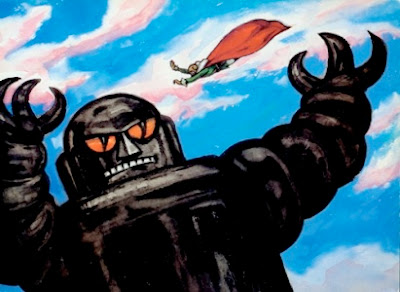
Arqueologías del animé y del extended comic
Acerca de “Manga Kamishibai” de Eric Nash
Por Shaun Manning

"There's a lot of parallels that you can see with later popular Japanese media like manga and anime," Nash told CBR. "All of the tropes are there--giant robots, monsters with magical powers, costumed superheroes—probably the world's first costumed superhero, the Golden Bat in the 1930s, even preceding American pulp heroes like Doc Savage or American comic book heroes, like the Phantom."

Nash points to the "curious media history" of Japanese art going back to 11th-century Buddhist scrolls as a factor in kamishibai, which is unique to the Japanese culture. "More recently, their history with film is slightly different from ours," the author explained. "During the silent era, they had what were called benshi, actors who stood by the side of the screen and narrated the action and did all of the characters' voices. This lasted well into the sound period, because Japanese weren't familiar with English-language films anyway. So these benshi were treated like movie stars, people would go to specific theatres to see a specific actress or actor. And kamishibai kind of took over this role." Nash noted that, when television first appeared in Japan, it was dubbed "electronic kamishibai."

Much like the classic American comics image of Captain America punching out Hitler, kamishibai were used as propaganda in Japan during World War II. Unlike the sturdy kamishibai boards previously produced, wartime stories were mass-produced on cheaper paper, yet nevertheless commanded an audience. "These were, of course, officially reviewed by the government," Nash noted of kamishibai during WWII. "These usually took two forms: one is propaganda about the Japanese winning the war--they were rarely shown in defeat, even if that happened [in the real world]. The other stories were about heroic sacrifice."

"Manga Kamishibai" also describes how, following Japan's surrender, many rural Japanese learned of their country's American-written constitution through kamishibai. "Japan is incredibly poor immediately after the war. People had very little to subsist on, especially in the farm areas, and nothing really to trade or to do," Nash said. "So kamishibai probably reached its peak during this period, with an audience of about five million people a day. And they would entertain and inform people, kind of like a nightly news to tell people what was going on. The Americans wanted to control the imagery that the Japanese saw, so all references to Japan's martial past were censored, and instead they got stories about baseball and anything American. Anything Japanese was suppressed. At first, MacArthur and the Americans wanted to suppress the militaristic streak in Japan, but immediately after that, they tryed to suppress the left-leaning, or Communist, kamishibai. You see that, in the first couple years, it's immediately more of a concern. The country then enlisted some on the right to combat these."

As streetcorner kamishibai faded with the increasing popularity of television and film, artists such as Shigeru Mizuki made the transition from illustrating story boards to manga, with "GeGeGe no Kitaro" an early classic of the medium. Nash said that the influences of American film on kamishibai would in turn affect composition in Japanese comics. "You can tell, there's one [kamishibai] about a Western adventure, and it's totally framed like a John Ford movie. Frames within frames, depth of field - that must have come from cinema," he said.

Today, kamishibai remains as an educational medium used in schools, but the pop culture aspect and public performances have vanished, with no sign of a renaissance. The medium, in fact, has been largely ignored even in an art-historical context. "It's sort of the status comics had in the '50s, [when] they were shunned as second-rate material. So I think, even in Japan, they haven't come to appreciate this art form fully," Nash said. "It's been forgotten and secreted away in libraries for a long time. So I think my book is the first to really explore the continent of this stuff. There's a lot more of it, but this is certainly the first English-language book about kamishibai.

"I think that it's visually fantastic medium, and [the book] will be interesting to those interested in the origins of manga and where Japanese animation comes from."
